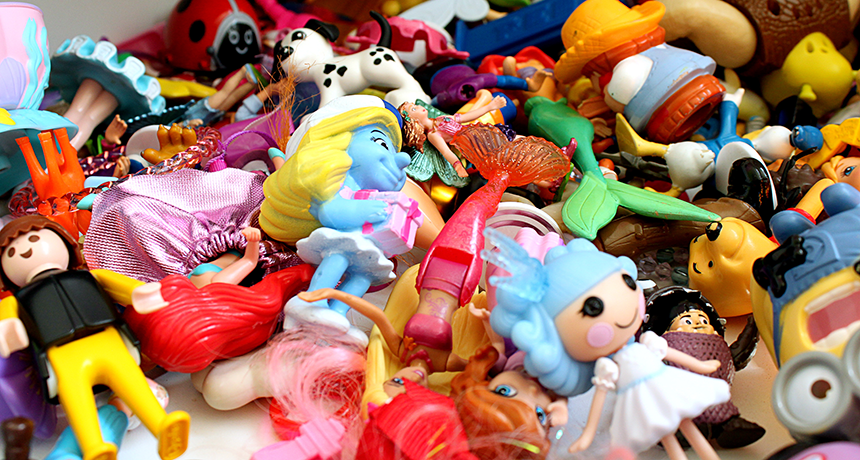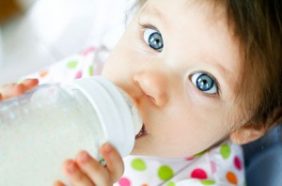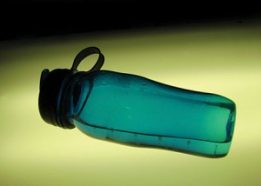Our plastic world
Some products contain chemicals that can pose a serious health risk

Today’s toys are almost invariably made of plastic. But the toy box is hardly the only place where this lightweight, inexpensive material has invaded our lives.
cjmacer/iStockphoto
By Emily Sohn

Try to count everything you use that’s made of plastic. I dare you.
Done yet? I didn’t think so.
Your list may include toys, yogurt containers and pens. But did you remember to include telephones, bike helmets, spatulas and shower curtains? How about straws, food wrappers, picture frames and the seat covers on your school bus?
Plastic is everywhere because plastic is an extremely useful material. It is cheap, strong and lightweight. What’s more, it can take on nearly any form or shape, from soft and stretchy to hard and glasslike.
Plastic, however, is far from perfect. It may even be bad for us, according to a growing body of research. Studies now suggest that toxic chemicals can get out of some types of plastic, get into our bodies, and cause a variety of health problems, including cancer, birth defects and attention deficit hyperactivity disorder (ADHD).
Fetuses and young children seem to be at greatest risk. And since babies tend to put plastic things (and everything else) in their mouths, many parents are worried.
Two types of chemicals in particular have raised special concern lately. They are called phthalates (pronounced thal’ ātz) and bisphenol (biz fē’ nawl) A, BPA for short. Not all plastic products contain them. But the ones that do are surrounded by controversy. That’s because experts disagree about how dangerous these chemicals are.
If you follow the news in coming months, you’ll notice more and more stories about phthalates and BPA. And as the research builds, it’s up to you to decide how plastic will fit into your life. So, what do you need to know to make smart choices about plastic?
From Bottle to Body
Plastic is a single word, but plastic isn’t just one thing. Think about how different a food wrapper is from a water bottle. What all plastics share in common are plasticizers — special chemicals that allow the material to be molded into nearly any shape or texture. Plasticizers are added to plastic during the manufacturing process.
Phthalates and BPA are two types of plasticizers that work in different ways. Phthalates add softness and squishiness to things like shampoo bottles, raincoats and rubber duckies. These molecules are also used in perfumes and makeup. BPA, on the other hand, gives a hard, clear, almost glasslike feel to products such as baby bottles, blender bowls and reusable, see-through Nalgene-brand water bottles (milky-colored, soft Nalgene bottles don’t contain BPA). BPA also appears in the lining of many food and soda cans, in DVDs and in other unexpected places.
Widespread use of BPA and phthalates worries many scientists because both chemicals belong to a group called hormone disruptors. In the body they act like hormones. Hormones, such as estrogen and testosterone, are two of the body’s important messenger molecules. They can tell cells when to turn on or off the cells’ genetic material. That’s how hormones direct the complicated development of a fetus from just a few cells into an actual baby with arms, legs, ears and organs. They also control growth in all of us. They even control the changes at puberty that get our bodies ready to become adults.
When some other chemical imitates a hormone, though, our actual hormones can’t do what they need to do. That can cause all sorts of problems. In hundreds of experiments, animals exposed to hormone disruptors in the womb went on to develop breast cancer, early puberty, diabetes, obesity, behavioral problems and other health issues.
“What we know is that BPA and phthalates disrupt hormones, and that hormones are necessary for normal human development, brain development and reproductive development,” says David Wallinga, director of the Institute for Agriculture and Food Policy’s Food and Health Program in Minneapolis.
Especially worrisome, Wallinga says, is that just tiny doses of a hormone disruptor can have a big impact. That’s because hormones work at extremely low levels in the body, so it doesn’t take much to get in their way.
Most of us already have tiny amounts of hormone disruptors in our bodies. A recent study by the U. S. Centers for Disease Control and Prevention found traces of BPA in 93 percent of the more than 2,500 people tested in the United States.
How do these chemicals get into us? When plastic is heated in the microwave or dishwasher, chewed on or scratched, the chemicals can seep out of the plastic. Even though we can’t see these molecules, we eat them, drink them and breathe them in.
Scientists and parents are especially worried about young children, who tend to chew on everything, including plastic. BPA is a common ingredient in baby bottles, teething rings, sippy cups, baby-formula cans and other products specifically designed to go into the mouths of little kids. Kids are a cause of concern both because they are likely to be exposed to plastics more than adults and because their bodies are more sensitive to the risky chemicals. Hormones play a particularly important role in the developing bodies of both babies and fetuses.
The Debate Goes On
Despite the growing sense of worry, debates about what to do continue between those concerned about the chemicals, the plastics industry and the government agencies charged with deciding on what’s safe and what’s not. That’s because there’s still no proof that BPA and phthalates are making people sick. So far, most experiments have involved animals and cells growing in test tubes.

In humans, the strongest evidence of harm comes from associations: People who have been exposed unintentionally to BPA and phthalates seem to develop the same types of health problems as animals that are deliberately exposed. In science, though, you need to show that one event directly causes another. It’s not enough to just observe that chemical exposure and diseases happen to the same people: The two might just be a coincidence.
Yet, direct proof in humans may never come, Wallinga says. For ethical reasons, researchers can’t expose pregnant women to risky chemicals, then wait to see what happens.
Scientists have also had trouble repeating some of the studies that make these plasticizers look bad, says Steven Hentges, a chemist from the American Chemistry Council, a plastics-industry group in Arlington, Virginia. The group sponsors a number of websites, which compile news reports and studies showing that plasticizers are safe.
“Consumers would have to eat more than 500 pounds of food and beverages in contact with [BPA-containing plastic] every day of their lives to exceed exposure levels determined to be safe,” reads a fact sheet on one such site, called factsonplastic.org.
But one new study that was reported online in the Sept. 13 Science News, found that in human body fat, BPA suppresses a real hormone that normally protects people from heart attacks and type 2 diabetes. The amount of BPA that it took to do this was the same as what is found in most people’s blood. These values were well below values that the government has declared are safe.
That story also reported on a Spanish study that showed BPA — in amounts typical of what’s already found in people — can alter the body’s production of insulin, a hormone that breaks down sugars. This study was conducted in mice, not people. But its findings suggest BPA might help encourage the body’s development of diabetes, a life-threatening hormonal disease where the body can’t use sugar appropriately.
A story in the Oct. 11 Science News actually links BPA concentrations in people to heart disease, changes in liver function and type 2 diabetes.
After evaluating some data — but not all of these studies — many large governmental agencies have concluded that there still is nothing to worry about. In July, Europe’s food safety organization issued a statement saying that BPA-containing products are fine for everyone, including kids. In August, a draft (not final) report by the U.S. Food and Drug Administration came to similar conclusions.
But several large groups of well-known scientists have expressed concern about hormone disruptors in plastics. And some states and countries are taking action.
New Rules, New Products
Dozens of countries, including the European Union, Japan, Canada and Mexico have already banned phthalates from products made for children younger than 3. California and Washington State have done the same. And a number of other states are considering similar rules.
As for BPA, Canada became the first country to ban the chemical from baby bottles in April. A dozen states are considering it.
Even in places where it is legal to sell baby products that contain these chemicals, many major stores are stocking their shelves with versions that don’t contain them. Toys“R”Us and Wal-Mart are two examples. At the same time, more and more manufacturers are making BPA-free and phthalate-free versions of their products.
If you want to know what’s in the plastics you eat and drink out of, look for the small number that’s usually etched into the bottom of the product. In food and drink containers, the numbers 1, 2, 4, and 5 are free of BPA and phthalates. But avoid microwaving even these plastics —or reusing them.(To learn more about safety and plastics, visit healthylegacy.org.
If you’re concerned, wood, glass and cloth make good alternatives to plastic. Or you can buy plastic toys made in countries that have bans on certain plasticizers.
“I have two rubber duckies sitting on my desk,” says Lindsay Dahl, project coordinator at Healthy Legacy, an advocacy group that opposes toxic chemicals in everyday products. “One has phthalates. One doesn’t. The one that does is sold in the United States. The one that doesn’t is sold in Europe.”
When in doubt, call the company to ask about what’s in their plastics. While you’re on the phone, tell them what you think about the issue. They might be interested to know that kids are keeping an eye on them.
Teacher’s Question Sheet: Our Plastic World
SCIENCE
Before reading:
1. What do you own that’s made out of plastic?
2. Why do you think those items were not made out of some other substance — such as wood, glass, or metal?
3. What do you think the advantages are of something being made out of plastic?
During reading:
1. What is plastic? Why might some types pose a health concern?
2. What is a plasticizer? How does it work?
3. What are hormones and how can a building block of plastics resemble a hormone?
4. How strong is the evidence that ingredients of plastics might affect health?
5. Are all members of the population at similar risk from plastics’ ingredients? Why or why not?
After Reading
1. Now that you know there are potential risks from using plastics — but that the human risks have not been proven yet — how important do you think it would be to avoid using plastic items?
2. For which plastic items in your home or school do you think there might be good substitutes? For which can you think of no substitutes?
3. Plastic baby bottles have been considered a potentially big concern. Moms used to use glass bottles. What are at least three reasons why modern moms might prefer plastic?
4. The author says these junk pieces travel at breakneck speed. Do you think that would make them more or less of a danger to astronauts in orbit?
5. If you think plastic items may pose a health risk, what should we do with all of those that are in our homes? How would you discard them? What might be the best way to ensure that plastic trash doesn’t become a hazard in the trash?
6. Do you think plastic trash in lakes and streams would pose a risk to fish and other aquatic life? Why or why not?
SOCIAL STUDIES
1. How has the widespread availability of plastics in the last 50 years changed society? To figure out, imagine a world where all of today’s plastics were instead made of wood, rubber, metal, stone or glass.
2. What features of plastic make them better than wood, rubber, metal, stone or glass? Hint: Compare the cost, weight and flexibility of plastic items against similar materials made from wood, rubber, metal, stone or glass.
3. If plastics were totally nontoxic, that is posed no health risk, what aspects of plastic items might make less desirable than similar items made from other materials?
LANGUAGE ARTS
1. Write a short essay on why plastic baby bottles are better or worse for today’s infants. Imagine having to explain to your mom or a neighbor — someone who knows nothing about the science plastics — why concerns have been raised about the safety of plastics. Explain why you think this mom should or should not be concerned about these new studies.
2. Imagine a world in which all plastics were banned. Describe in a 10 sentences or less how this would change your environment? Hint: Consider what things in your bedroom, your game room, your kitchen and your yard might be different.
3. Hold a classroom debate on the value of keeping plastics. Let one group argue persuasively that any benefits they pose would outweigh their risks. Let the other group argue that their potential risks outweigh the benefits.







